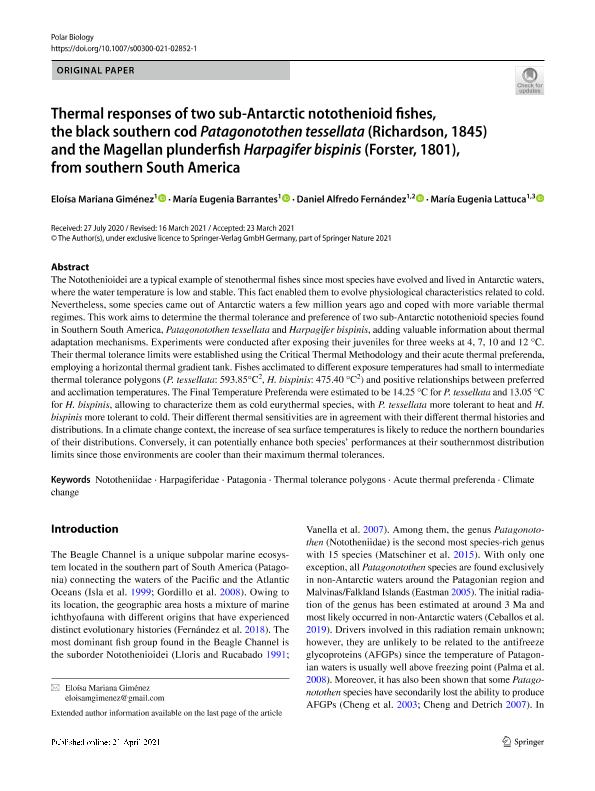Artículo
Thermal responses of two sub-Antarctic notothenioid fishes, the black southern cod Patagonotothen tessellata (Richardson, 1845) and the Magellan plunderfish Harpagifer bispinis (Forster, 1801), from southern South America
Giménez, Eloísa Mariana ; Barrantes, María Eugenia
; Barrantes, María Eugenia ; Fernandez, Daniel Alfredo
; Fernandez, Daniel Alfredo ; Lattuca, María Eugenia
; Lattuca, María Eugenia
 ; Barrantes, María Eugenia
; Barrantes, María Eugenia ; Fernandez, Daniel Alfredo
; Fernandez, Daniel Alfredo ; Lattuca, María Eugenia
; Lattuca, María Eugenia
Fecha de publicación:
04/2021
Editorial:
Springer
Revista:
Polar Biology
ISSN:
0722-4060
Idioma:
Inglés
Tipo de recurso:
Artículo publicado
Clasificación temática:
Resumen
The Notothenioidei are a typical example of stenothermal fishes since most species have evolved and lived in Antarctic waters, where the water temperature is low and stable. This fact enabled them to evolve physiological characteristics related to cold. Nevertheless, some species came out of Antarctic waters a few million years ago and coped with more variable thermal regimes. This work aims to determine the thermal tolerance and preference of two sub-Antarctic notothenioid species found in Southern South America, Patagonotothen tessellata and Harpagifer bispinis, adding valuable information about thermal adaptation mechanisms. Experiments were conducted after exposing their juveniles for three weeks at 4, 7, 10 and 12 °C. Their thermal tolerance limits were established using the Critical Thermal Methodology and their acute thermal preferenda, employing a horizontal thermal gradient tank. Fishes acclimated to different exposure temperatures had small to intermediate thermal tolerance polygons (P. tessellata: 593.85°C2, H. bispinis: 475.40 °C2) and positive relationships between preferred and acclimation temperatures. The Final Temperature Preferenda were estimated to be 14.25 °C for P. tessellata and 13.05 °C for H. bispinis, allowing to characterize them as cold eurythermal species, with P. tessellata more tolerant to heat and H. bispinis more tolerant to cold. Their different thermal sensitivities are in agreement with their different thermal histories and distributions. In a climate change context, the increase of sea surface temperatures is likely to reduce the northern boundaries of their distributions. Conversely, it can potentially enhance both species’ performances at their southernmost distribution limits since those environments are cooler than their maximum thermal tolerances.
Archivos asociados
Licencia
Identificadores
Colecciones
Articulos(CADIC)
Articulos de CENTRO AUSTRAL DE INVESTIGACIONES CIENTIFICAS
Articulos de CENTRO AUSTRAL DE INVESTIGACIONES CIENTIFICAS
Citación
Giménez, Eloísa Mariana; Barrantes, María Eugenia; Fernandez, Daniel Alfredo; Lattuca, María Eugenia; Thermal responses of two sub-Antarctic notothenioid fishes, the black southern cod Patagonotothen tessellata (Richardson, 1845) and the Magellan plunderfish Harpagifer bispinis (Forster, 1801), from southern South America; Springer; Polar Biology; 44; 6; 4-2021; 1055-1067
Compartir
Altmétricas



